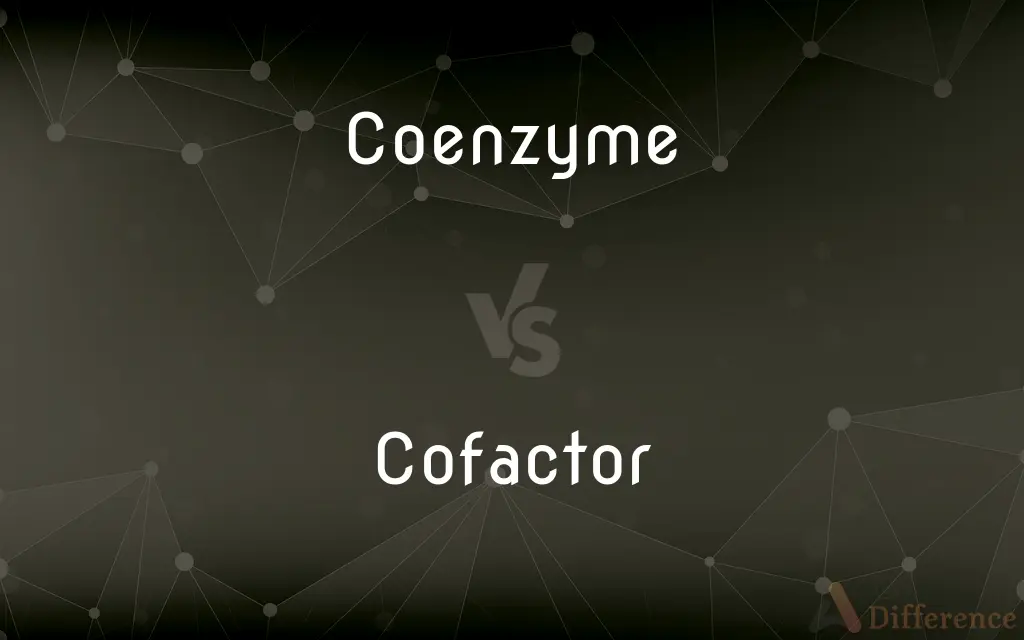Coenzyme vs. Cofactor — What's the Difference?
By Tayyaba Rehman & Urooj Arif — Updated on March 19, 2024
Coenzymes are organic molecules that assist enzymes, while cofactors are inorganic ions or metal ions aiding enzymatic reactions.

Difference Between Coenzyme and Cofactor
Table of Contents
ADVERTISEMENT
Key Differences
Coenzymes and cofactors are both essential for the catalytic activities of enzymes, but they play distinct roles and have different natures. Coenzymes are organic, non-protein molecules that bind to enzymes and assist in the transfer of chemical groups between molecules. These are often derived from vitamins and are crucial for the functionality of many enzymes, acting as temporary carriers of atoms or functional groups during the enzymatic reaction. Cofactors, on the other hand, can be either inorganic ions (such as metal ions like zinc, magnesium, or iron) or organic molecules, but when the organic molecules assist enzymes, they are specifically referred to as coenzymes, making all coenzymes a subset of cofactors.
Coenzymes are typically involved in the transfer of electrons, protons, or chemical groups within the biochemical pathways, making them integral to a wide array of metabolic reactions. For instance, NAD+ (Nicotinamide adenine dinucleotide) acts as a coenzyme in redox reactions, accepting electrons and protons to form NADH. Conversely, cofactors like magnesium ions might stabilize the structures of enzymes and substrates, thereby enhancing the reaction rate without directly participating in the transfer of electrons or groups.
The specificity of coenzymes to their enzyme partners is less about binding to the enzyme's active site and more about their role as carriers or intermediates in the reaction. Coenzymes often have a broader specificity, able to associate with multiple enzymes that catalyze similar types of reactions. Cofactors, especially the inorganic ions, usually act by enhancing the enzyme's ability to bind to its substrate or by participating in the stabilization of the reaction intermediates, showing a form of specificity through their interaction with specific enzyme structures.
Coenzymes, being organic and often derived from dietary vitamins, highlight the intersection of nutrition and biochemistry, illustrating how essential nutrients contribute to enzymatic reactions crucial for life. This dependency underscores the importance of a balanced diet rich in vitamins for metabolic health. Cofactors, particularly the inorganic ones, emphasize the role of minerals in biological systems, further linking diet to enzymatic activity but also highlighting how organisms utilize elemental substances from their environment in biochemical pathways.
While both coenzymes and cofactors are vital for the catalytic activity of enzymes, coenzymes are a specific type of cofactor that are organic molecules, often vitamin-derived, and participate directly in the enzymatic reaction by transferring chemical groups. In contrast, cofactors include a broader category of substances that can be either inorganic ions or organic molecules (including coenzymes), which assist in the enzymatic reaction by a variety of mechanisms, including stabilization of enzyme structure, substrate binding, and reaction intermediate formation.
ADVERTISEMENT
Comparison Chart
Nature
Organic molecules
Inorganic ions or organic molecules
Source
Often derived from vitamins
Minerals or organic molecules
Role in Reactions
Transfer of electrons, protons, or chemical groups
Stabilization of enzymes and substrates, assist in the biochemical reaction
Examples
NAD+, FAD, coenzyme A
Zinc, magnesium, iron ions
Specificity
Broad, can work with multiple enzymes
Specific to the enzyme's structural or catalytic needs
Compare with Definitions
Coenzyme
Reusable and often associated with multiple enzymes.
Coenzyme A is crucial in both the citric acid cycle and fatty acid synthesis.
Cofactor
A non-protein chemical compound or metallic ion that is required for an enzyme's biological activity.
Magnesium ions act as a cofactor for many enzymes.
Coenzyme
Derived from vitamins, assisting in the transfer of chemical groups.
Vitamin B6 is a precursor to the coenzyme PLP.
Cofactor
Essential for the structural integrity of certain enzymes.
Zinc cofactors are crucial for the activity of alcohol dehydrogenase.
Coenzyme
An organic molecule serving as a cofactor that helps enzymes catalyze reactions.
NAD+ is a coenzyme involved in redox reactions.
Cofactor
Can be either inorganic or organic, assisting enzymes in catalysis.
Iron is a cofactor necessary for the function of hemoglobin.
Coenzyme
Integral to metabolic processes and energy production.
FAD is a coenzyme that acts as an electron carrier in the electron transport chain.
Cofactor
Plays a broader role in enzymatic reactions than coenzymes.
Cofactors are indispensable for the catalytic activity of numerous enzymes.
Coenzyme
Essential for the functioning of enzymes that mediate biochemical transformations.
Coenzymes play a vital role in converting substrates into products.
Cofactor
Enhances enzyme stability or substrate binding.
Copper ions serve as cofactors in oxidative reactions.
Coenzyme
An organic substance that reversibly combines with a specific protein, the apoenzyme, and with a substrate to form an active enzyme system.
Cofactor
One of two or more contributing factors.
Coenzyme
(biochemistry) Any small molecule that is necessary for the functioning of an enzyme.
Cofactor
A substance, such as a metallic ion or coenzyme, that must be associated with an enzyme for the enzyme to function.
Coenzyme
A molecule that is essential for the activity of some enzymes; it may exist free in solution within a living organism, but functions by binding to an enzyme to assist in catalyzing a reaction. The molecule itself may be temporarily changed during the reaction, but is ultimately restored to its original form. Many vitamins function as coenzymes.
Cofactor
A contributing factor.
Coenzyme
A small molecule (not a protein but sometimes a vitamin) essential for the activity of some enzymes
Cofactor
(biochemistry) A substance, especially a coenzyme or a metal, that must be present for an enzyme to function.
Cofactor
(biochemistry) A molecule that binds to and regulates the activity of a protein.
Cofactor
(mathematics) The result of a number being divided by one of its factors.
Cofactor
The signed determinant of the submatrix produced by removing the row and column containing a specified element; primarily used in the recursive definition and calculation of the determinant of a matrix.
Cofactor
A substance (as a coenzyme) that must join with another to produce a given result
Common Curiosities
How do dietary deficiencies affect coenzymes and cofactors?
Deficiencies can impair the body's ability to produce coenzymes and affect the availability of cofactors, leading to metabolic disorders.
Are all coenzymes also cofactors?
Yes, all coenzymes are a specific type of cofactor, but not all cofactors are coenzymes.
How do coenzymes and cofactors reach the enzymes?
They typically diffuse freely in the cell and bind to their enzyme targets through specific interaction sites.
Are coenzymes consumed in the reaction?
Coenzymes participate in the reaction but are often recycled and reused, not consumed.
How does the body obtain coenzymes and cofactors?
Coenzymes are typically synthesized from vitamins obtained from the diet, while cofactors can be absorbed as dietary minerals or through other biochemical pathways.
Can an enzyme require both a coenzyme and a cofactor?
Yes, some enzymes require both a coenzyme and an inorganic cofactor to function properly.
Can cofactors be considered a part of the enzyme's structure?
Some cofactors are tightly bound to the enzyme, almost considered a permanent part of it, while others are loosely associated.
Are cofactors reused in enzymatic reactions?
Inorganic cofactors can be reused, but they do not undergo chemical changes during the reaction like some coenzymes do.
What happens if a cofactor is missing?
The enzyme's activity can be reduced or completely inhibited, affecting the metabolic pathway it catalyzes.
Do all enzymes need coenzymes or cofactors?
Not all enzymes require coenzymes or cofactors, but many do for their catalytic activity.
How are coenzymes and cofactors studied?
They are studied through biochemical assays, structural biology techniques, and nutritional research to understand their role in enzymatic reactions and metabolism.
Can the same coenzyme work with different enzymes?
Yes, coenzymes often work with multiple enzymes involved in similar types of biochemical reactions.
Share Your Discovery

Previous Comparison
Allele vs. Trait
Next Comparison
Splinter vs. SliverAuthor Spotlight
Written by
Tayyaba RehmanTayyaba Rehman is a distinguished writer, currently serving as a primary contributor to askdifference.com. As a researcher in semantics and etymology, Tayyaba's passion for the complexity of languages and their distinctions has found a perfect home on the platform. Tayyaba delves into the intricacies of language, distinguishing between commonly confused words and phrases, thereby providing clarity for readers worldwide.
Co-written by
Urooj ArifUrooj is a skilled content writer at Ask Difference, known for her exceptional ability to simplify complex topics into engaging and informative content. With a passion for research and a flair for clear, concise writing, she consistently delivers articles that resonate with our diverse audience.














































